Purposeful Communication and Organizational Effectiveness Report
VerifiedAdded on 2022/10/07
|14
|4032
|30
Report
AI Summary
This report delves into the critical role of purposeful communication in enhancing organizational effectiveness. It begins by defining communication and purposeful communication through various dictionary definitions, establishing a foundation for understanding the concepts. The report then explores the concept of effective communication, its components, and its processes within organizations, including the use of memos, reports, and notice boards. It highlights the importance of aligning organizational purpose, brand, strategy, and culture through communication, emphasizing how effective communication fosters employee engagement and minimizes conflicts. The report also examines the application of self-awareness and social intelligence skills in leadership communication, stressing their role in understanding and responding to diverse situations and emotions. Furthermore, it outlines how effective communication skills can drive paradigm shifts and behavior change, contributing to organizational success. A systemic communication framework is developed for application within the organization. Finally, the report focuses on developing fluency in language, body, and emotion to enhance leadership communication, with the goal of adopting a coaching approach to individual, team, and organizational change. This comprehensive analysis provides valuable insights for students seeking to understand and apply purposeful communication strategies in leadership and organizational settings. The report also explores the importance of organizational culture and how to build a coaching culture within an organization.
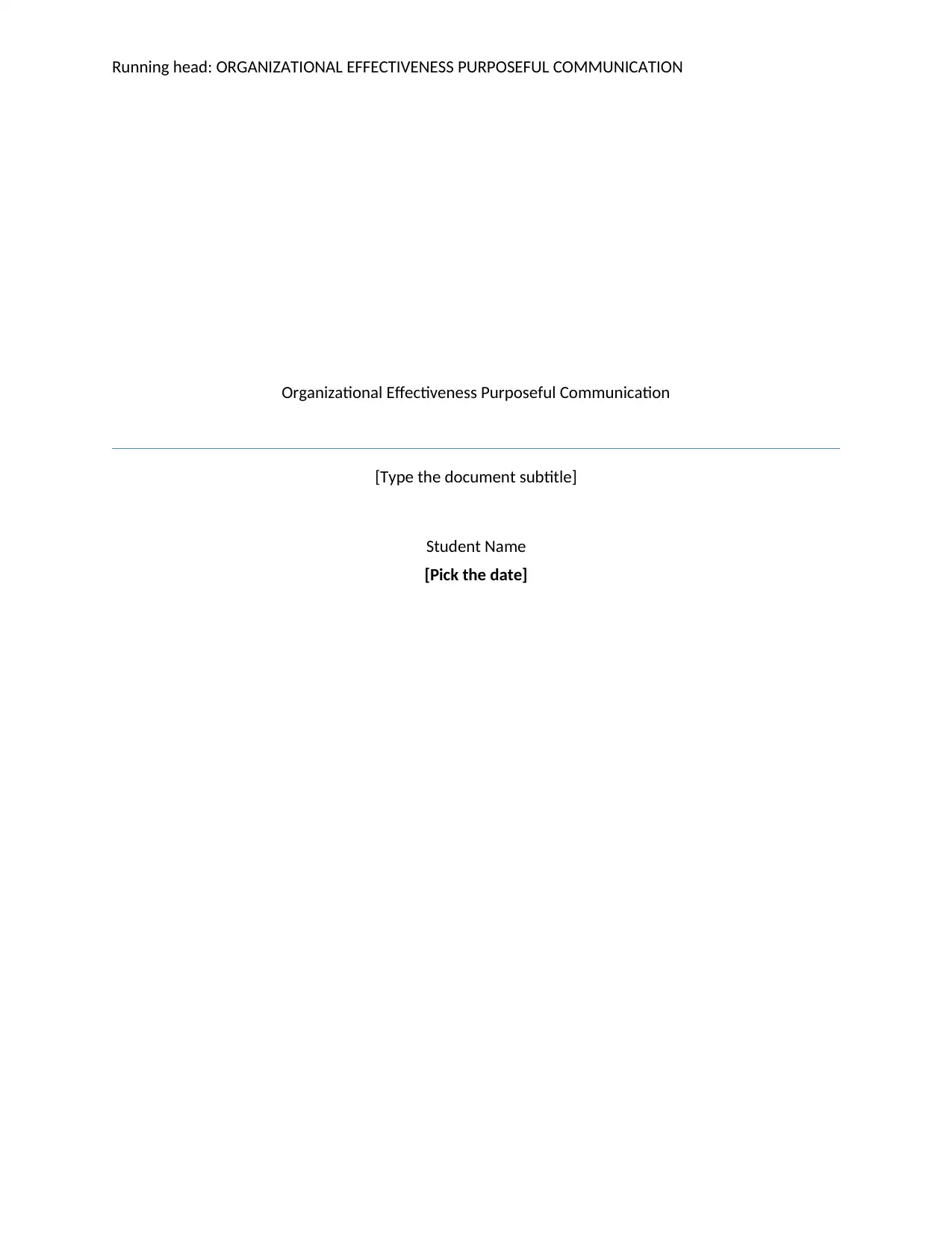
Running head: ORGANIZATIONAL EFFECTIVENESS PURPOSEFUL COMMUNICATION
Organizational Effectiveness Purposeful Communication
[Type the document subtitle]
Student Name
[Pick the date]
Organizational Effectiveness Purposeful Communication
[Type the document subtitle]
Student Name
[Pick the date]
Paraphrase This Document
Need a fresh take? Get an instant paraphrase of this document with our AI Paraphraser
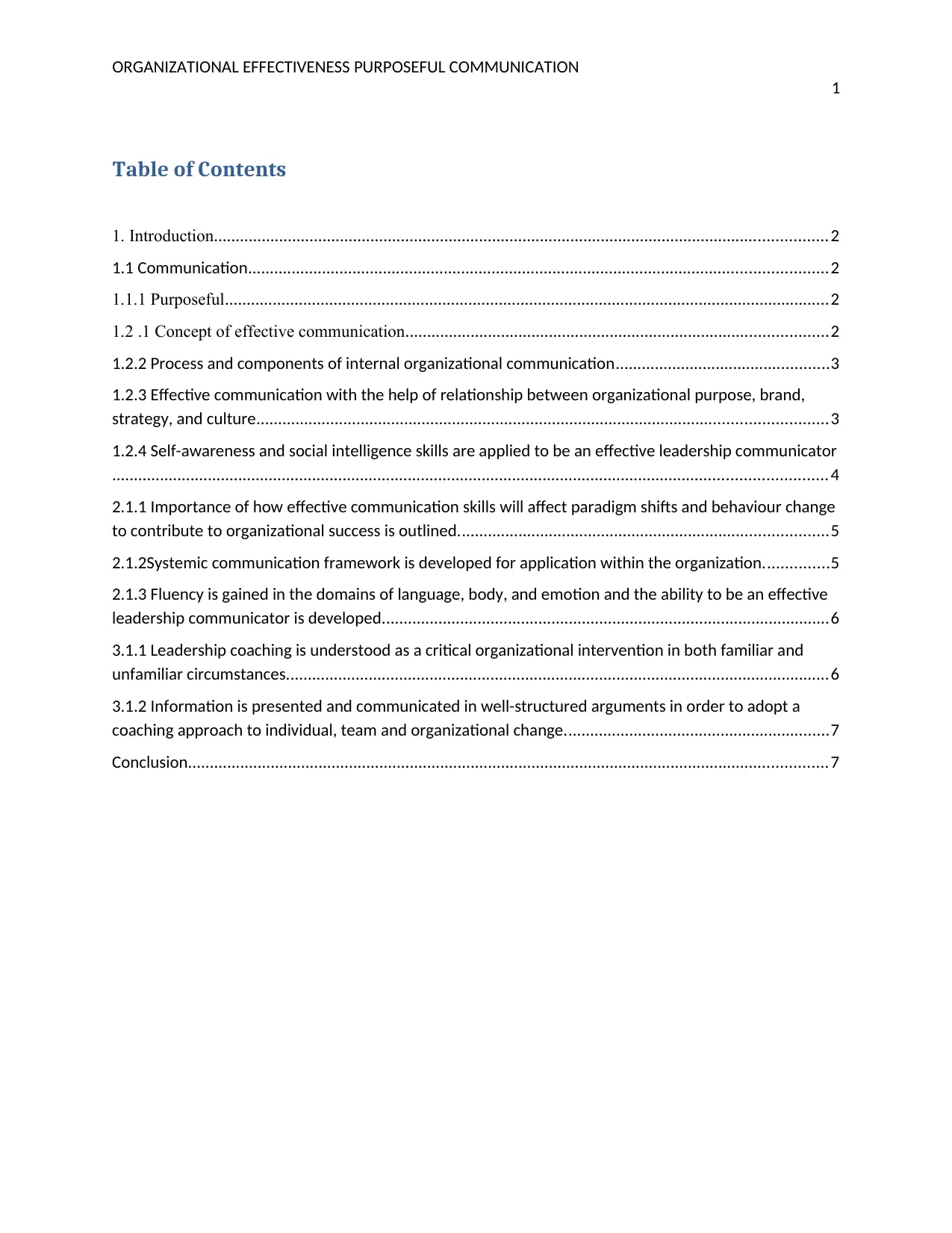
ORGANIZATIONAL EFFECTIVENESS PURPOSEFUL COMMUNICATION
1
Table of Contents
1. Introduction.............................................................................................................................................2
1.1 Communication.....................................................................................................................................2
1.1.1 Purposeful...........................................................................................................................................2
1.2 .1 Concept of effective communication.................................................................................................2
1.2.2 Process and components of internal organizational communication.................................................3
1.2.3 Effective communication with the help of relationship between organizational purpose, brand,
strategy, and culture...................................................................................................................................3
1.2.4 Self-awareness and social intelligence skills are applied to be an effective leadership communicator
.................................................................................................................................................................... 4
2.1.1 Importance of how effective communication skills will affect paradigm shifts and behaviour change
to contribute to organizational success is outlined.....................................................................................5
2.1.2Systemic communication framework is developed for application within the organization...............5
2.1.3 Fluency is gained in the domains of language, body, and emotion and the ability to be an effective
leadership communicator is developed.......................................................................................................6
3.1.1 Leadership coaching is understood as a critical organizational intervention in both familiar and
unfamiliar circumstances.............................................................................................................................6
3.1.2 Information is presented and communicated in well-structured arguments in order to adopt a
coaching approach to individual, team and organizational change.............................................................7
Conclusion...................................................................................................................................................7
1
Table of Contents
1. Introduction.............................................................................................................................................2
1.1 Communication.....................................................................................................................................2
1.1.1 Purposeful...........................................................................................................................................2
1.2 .1 Concept of effective communication.................................................................................................2
1.2.2 Process and components of internal organizational communication.................................................3
1.2.3 Effective communication with the help of relationship between organizational purpose, brand,
strategy, and culture...................................................................................................................................3
1.2.4 Self-awareness and social intelligence skills are applied to be an effective leadership communicator
.................................................................................................................................................................... 4
2.1.1 Importance of how effective communication skills will affect paradigm shifts and behaviour change
to contribute to organizational success is outlined.....................................................................................5
2.1.2Systemic communication framework is developed for application within the organization...............5
2.1.3 Fluency is gained in the domains of language, body, and emotion and the ability to be an effective
leadership communicator is developed.......................................................................................................6
3.1.1 Leadership coaching is understood as a critical organizational intervention in both familiar and
unfamiliar circumstances.............................................................................................................................6
3.1.2 Information is presented and communicated in well-structured arguments in order to adopt a
coaching approach to individual, team and organizational change.............................................................7
Conclusion...................................................................................................................................................7
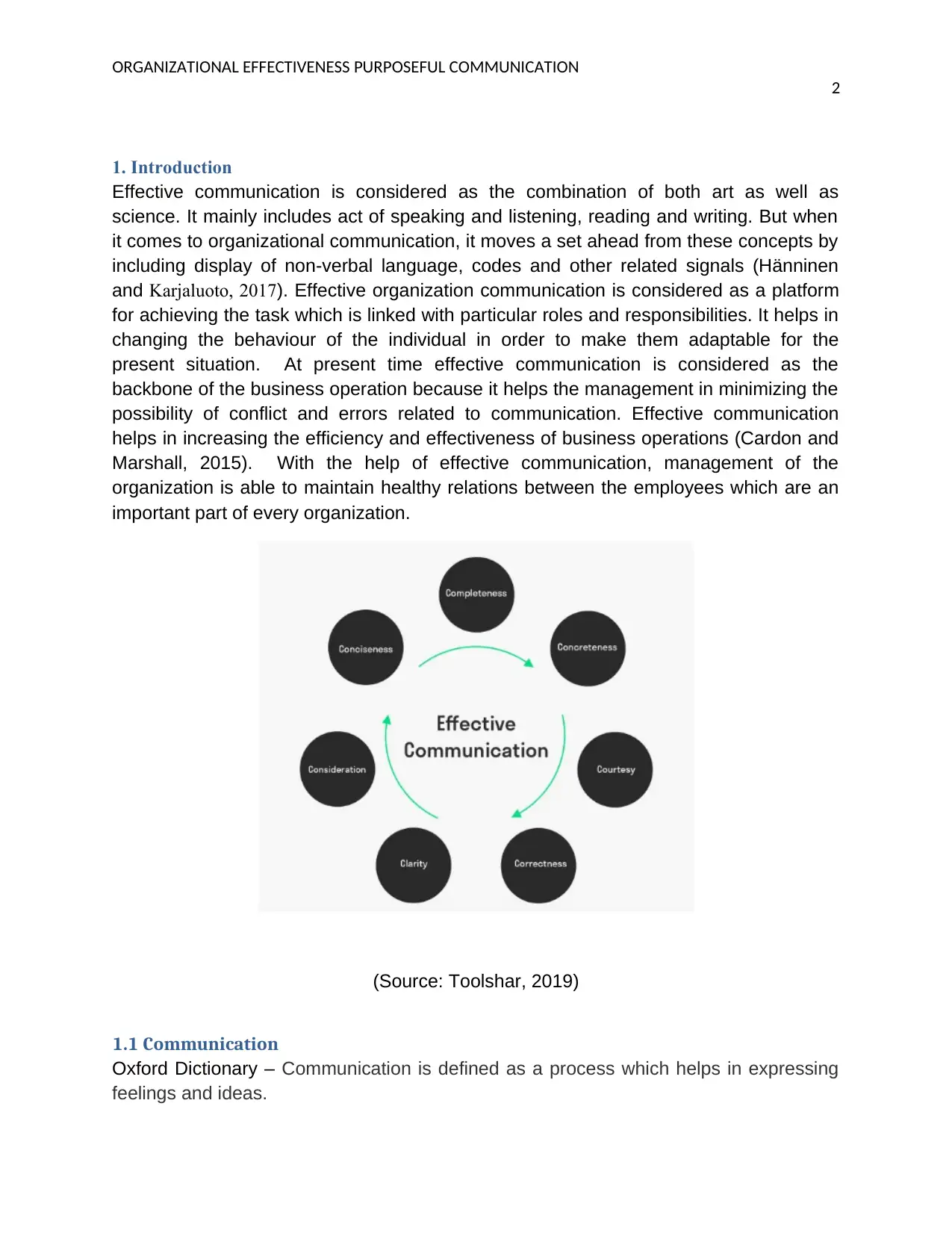
ORGANIZATIONAL EFFECTIVENESS PURPOSEFUL COMMUNICATION
2
1. Introduction
Effective communication is considered as the combination of both art as well as
science. It mainly includes act of speaking and listening, reading and writing. But when
it comes to organizational communication, it moves a set ahead from these concepts by
including display of non-verbal language, codes and other related signals (Hänninen
and Karjaluoto, 2017). Effective organization communication is considered as a platform
for achieving the task which is linked with particular roles and responsibilities. It helps in
changing the behaviour of the individual in order to make them adaptable for the
present situation. At present time effective communication is considered as the
backbone of the business operation because it helps the management in minimizing the
possibility of conflict and errors related to communication. Effective communication
helps in increasing the efficiency and effectiveness of business operations (Cardon and
Marshall, 2015). With the help of effective communication, management of the
organization is able to maintain healthy relations between the employees which are an
important part of every organization.
(Source: Toolshar, 2019)
1.1 Communication
Oxford Dictionary – Communication is defined as a process which helps in expressing
feelings and ideas.
2
1. Introduction
Effective communication is considered as the combination of both art as well as
science. It mainly includes act of speaking and listening, reading and writing. But when
it comes to organizational communication, it moves a set ahead from these concepts by
including display of non-verbal language, codes and other related signals (Hänninen
and Karjaluoto, 2017). Effective organization communication is considered as a platform
for achieving the task which is linked with particular roles and responsibilities. It helps in
changing the behaviour of the individual in order to make them adaptable for the
present situation. At present time effective communication is considered as the
backbone of the business operation because it helps the management in minimizing the
possibility of conflict and errors related to communication. Effective communication
helps in increasing the efficiency and effectiveness of business operations (Cardon and
Marshall, 2015). With the help of effective communication, management of the
organization is able to maintain healthy relations between the employees which are an
important part of every organization.
(Source: Toolshar, 2019)
1.1 Communication
Oxford Dictionary – Communication is defined as a process which helps in expressing
feelings and ideas.
⊘ This is a preview!⊘
Do you want full access?
Subscribe today to unlock all pages.

Trusted by 1+ million students worldwide
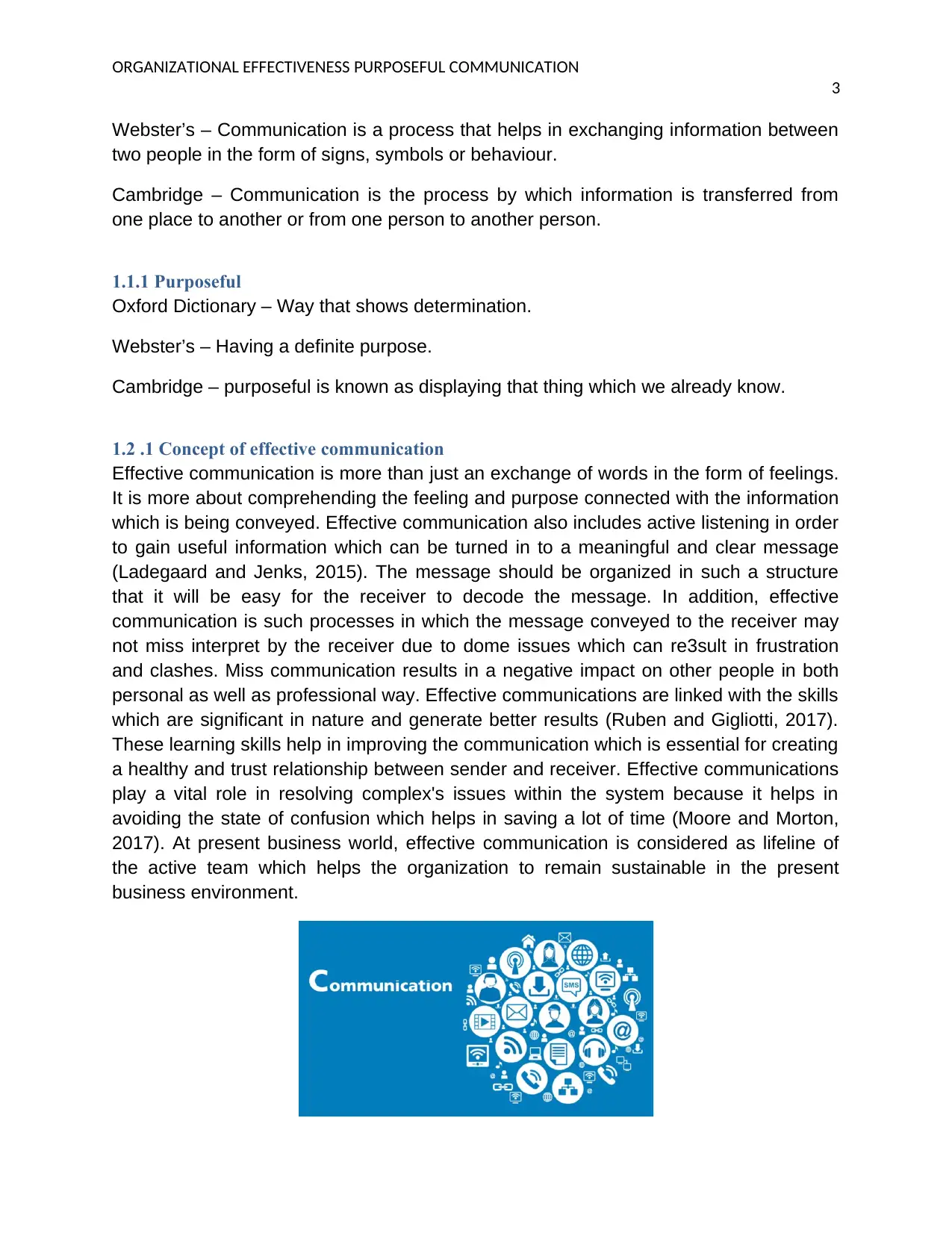
ORGANIZATIONAL EFFECTIVENESS PURPOSEFUL COMMUNICATION
3
Webster’s – Communication is a process that helps in exchanging information between
two people in the form of signs, symbols or behaviour.
Cambridge – Communication is the process by which information is transferred from
one place to another or from one person to another person.
1.1.1 Purposeful
Oxford Dictionary – Way that shows determination.
Webster’s – Having a definite purpose.
Cambridge – purposeful is known as displaying that thing which we already know.
1.2 .1 Concept of effective communication
Effective communication is more than just an exchange of words in the form of feelings.
It is more about comprehending the feeling and purpose connected with the information
which is being conveyed. Effective communication also includes active listening in order
to gain useful information which can be turned in to a meaningful and clear message
(Ladegaard and Jenks, 2015). The message should be organized in such a structure
that it will be easy for the receiver to decode the message. In addition, effective
communication is such processes in which the message conveyed to the receiver may
not miss interpret by the receiver due to dome issues which can re3sult in frustration
and clashes. Miss communication results in a negative impact on other people in both
personal as well as professional way. Effective communications are linked with the skills
which are significant in nature and generate better results (Ruben and Gigliotti, 2017).
These learning skills help in improving the communication which is essential for creating
a healthy and trust relationship between sender and receiver. Effective communications
play a vital role in resolving complex's issues within the system because it helps in
avoiding the state of confusion which helps in saving a lot of time (Moore and Morton,
2017). At present business world, effective communication is considered as lifeline of
the active team which helps the organization to remain sustainable in the present
business environment.
3
Webster’s – Communication is a process that helps in exchanging information between
two people in the form of signs, symbols or behaviour.
Cambridge – Communication is the process by which information is transferred from
one place to another or from one person to another person.
1.1.1 Purposeful
Oxford Dictionary – Way that shows determination.
Webster’s – Having a definite purpose.
Cambridge – purposeful is known as displaying that thing which we already know.
1.2 .1 Concept of effective communication
Effective communication is more than just an exchange of words in the form of feelings.
It is more about comprehending the feeling and purpose connected with the information
which is being conveyed. Effective communication also includes active listening in order
to gain useful information which can be turned in to a meaningful and clear message
(Ladegaard and Jenks, 2015). The message should be organized in such a structure
that it will be easy for the receiver to decode the message. In addition, effective
communication is such processes in which the message conveyed to the receiver may
not miss interpret by the receiver due to dome issues which can re3sult in frustration
and clashes. Miss communication results in a negative impact on other people in both
personal as well as professional way. Effective communications are linked with the skills
which are significant in nature and generate better results (Ruben and Gigliotti, 2017).
These learning skills help in improving the communication which is essential for creating
a healthy and trust relationship between sender and receiver. Effective communications
play a vital role in resolving complex's issues within the system because it helps in
avoiding the state of confusion which helps in saving a lot of time (Moore and Morton,
2017). At present business world, effective communication is considered as lifeline of
the active team which helps the organization to remain sustainable in the present
business environment.
Paraphrase This Document
Need a fresh take? Get an instant paraphrase of this document with our AI Paraphraser
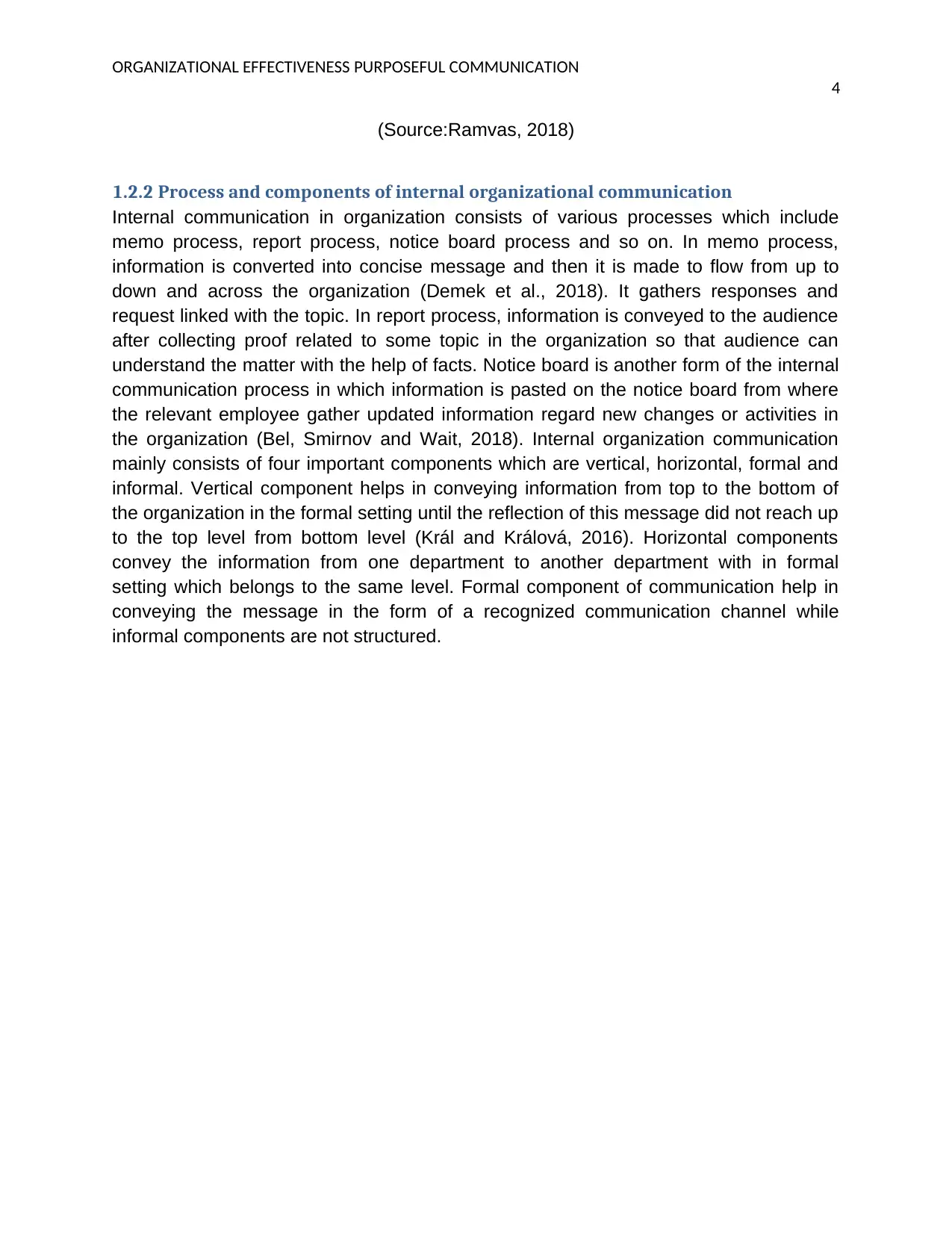
ORGANIZATIONAL EFFECTIVENESS PURPOSEFUL COMMUNICATION
4
(Source:Ramvas, 2018)
1.2.2 Process and components of internal organizational communication
Internal communication in organization consists of various processes which include
memo process, report process, notice board process and so on. In memo process,
information is converted into concise message and then it is made to flow from up to
down and across the organization (Demek et al., 2018). It gathers responses and
request linked with the topic. In report process, information is conveyed to the audience
after collecting proof related to some topic in the organization so that audience can
understand the matter with the help of facts. Notice board is another form of the internal
communication process in which information is pasted on the notice board from where
the relevant employee gather updated information regard new changes or activities in
the organization (Bel, Smirnov and Wait, 2018). Internal organization communication
mainly consists of four important components which are vertical, horizontal, formal and
informal. Vertical component helps in conveying information from top to the bottom of
the organization in the formal setting until the reflection of this message did not reach up
to the top level from bottom level (Král and Králová, 2016). Horizontal components
convey the information from one department to another department with in formal
setting which belongs to the same level. Formal component of communication help in
conveying the message in the form of a recognized communication channel while
informal components are not structured.
4
(Source:Ramvas, 2018)
1.2.2 Process and components of internal organizational communication
Internal communication in organization consists of various processes which include
memo process, report process, notice board process and so on. In memo process,
information is converted into concise message and then it is made to flow from up to
down and across the organization (Demek et al., 2018). It gathers responses and
request linked with the topic. In report process, information is conveyed to the audience
after collecting proof related to some topic in the organization so that audience can
understand the matter with the help of facts. Notice board is another form of the internal
communication process in which information is pasted on the notice board from where
the relevant employee gather updated information regard new changes or activities in
the organization (Bel, Smirnov and Wait, 2018). Internal organization communication
mainly consists of four important components which are vertical, horizontal, formal and
informal. Vertical component helps in conveying information from top to the bottom of
the organization in the formal setting until the reflection of this message did not reach up
to the top level from bottom level (Král and Králová, 2016). Horizontal components
convey the information from one department to another department with in formal
setting which belongs to the same level. Formal component of communication help in
conveying the message in the form of a recognized communication channel while
informal components are not structured.
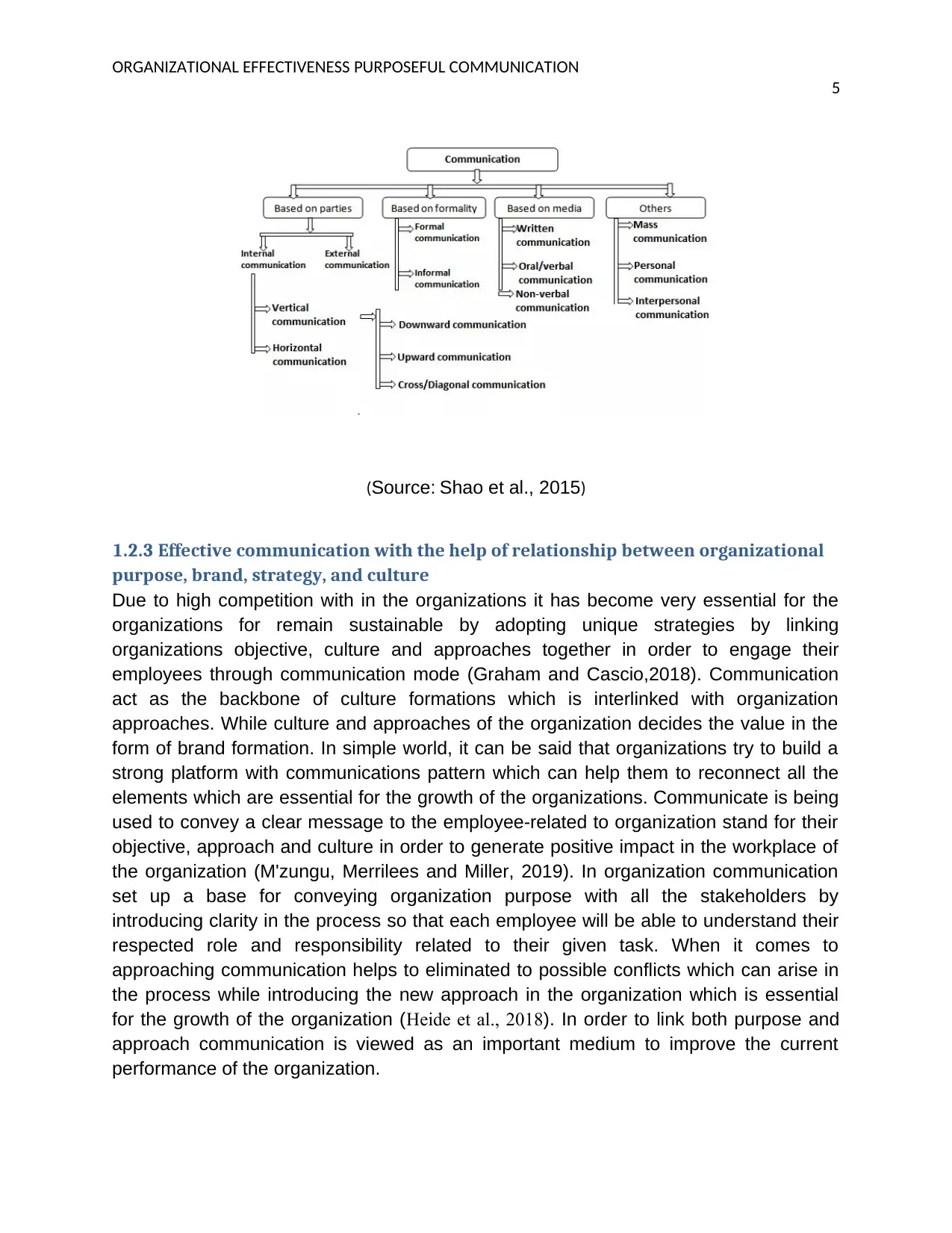
ORGANIZATIONAL EFFECTIVENESS PURPOSEFUL COMMUNICATION
5
(Source: Shao et al., 2015)
1.2.3 Effective communication with the help of relationship between organizational
purpose, brand, strategy, and culture
Due to high competition with in the organizations it has become very essential for the
organizations for remain sustainable by adopting unique strategies by linking
organizations objective, culture and approaches together in order to engage their
employees through communication mode (Graham and Cascio,2018). Communication
act as the backbone of culture formations which is interlinked with organization
approaches. While culture and approaches of the organization decides the value in the
form of brand formation. In simple world, it can be said that organizations try to build a
strong platform with communications pattern which can help them to reconnect all the
elements which are essential for the growth of the organizations. Communicate is being
used to convey a clear message to the employee-related to organization stand for their
objective, approach and culture in order to generate positive impact in the workplace of
the organization (M'zungu, Merrilees and Miller, 2019). In organization communication
set up a base for conveying organization purpose with all the stakeholders by
introducing clarity in the process so that each employee will be able to understand their
respected role and responsibility related to their given task. When it comes to
approaching communication helps to eliminated to possible conflicts which can arise in
the process while introducing the new approach in the organization which is essential
for the growth of the organization (Heide et al., 2018). In order to link both purpose and
approach communication is viewed as an important medium to improve the current
performance of the organization.
5
(Source: Shao et al., 2015)
1.2.3 Effective communication with the help of relationship between organizational
purpose, brand, strategy, and culture
Due to high competition with in the organizations it has become very essential for the
organizations for remain sustainable by adopting unique strategies by linking
organizations objective, culture and approaches together in order to engage their
employees through communication mode (Graham and Cascio,2018). Communication
act as the backbone of culture formations which is interlinked with organization
approaches. While culture and approaches of the organization decides the value in the
form of brand formation. In simple world, it can be said that organizations try to build a
strong platform with communications pattern which can help them to reconnect all the
elements which are essential for the growth of the organizations. Communicate is being
used to convey a clear message to the employee-related to organization stand for their
objective, approach and culture in order to generate positive impact in the workplace of
the organization (M'zungu, Merrilees and Miller, 2019). In organization communication
set up a base for conveying organization purpose with all the stakeholders by
introducing clarity in the process so that each employee will be able to understand their
respected role and responsibility related to their given task. When it comes to
approaching communication helps to eliminated to possible conflicts which can arise in
the process while introducing the new approach in the organization which is essential
for the growth of the organization (Heide et al., 2018). In order to link both purpose and
approach communication is viewed as an important medium to improve the current
performance of the organization.
⊘ This is a preview!⊘
Do you want full access?
Subscribe today to unlock all pages.

Trusted by 1+ million students worldwide
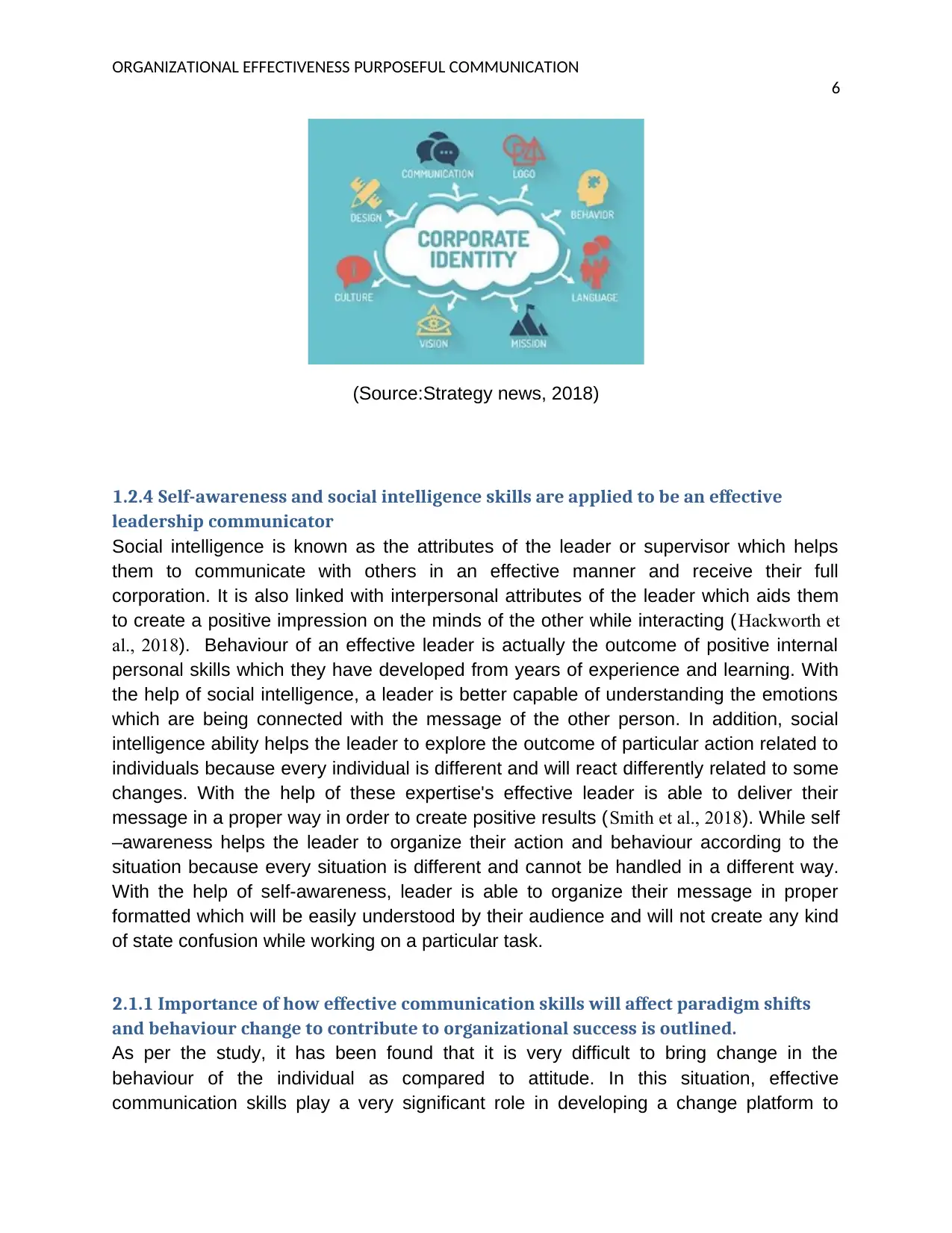
ORGANIZATIONAL EFFECTIVENESS PURPOSEFUL COMMUNICATION
6
(Source:Strategy news, 2018)
1.2.4 Self-awareness and social intelligence skills are applied to be an effective
leadership communicator
Social intelligence is known as the attributes of the leader or supervisor which helps
them to communicate with others in an effective manner and receive their full
corporation. It is also linked with interpersonal attributes of the leader which aids them
to create a positive impression on the minds of the other while interacting (Hackworth et
al., 2018). Behaviour of an effective leader is actually the outcome of positive internal
personal skills which they have developed from years of experience and learning. With
the help of social intelligence, a leader is better capable of understanding the emotions
which are being connected with the message of the other person. In addition, social
intelligence ability helps the leader to explore the outcome of particular action related to
individuals because every individual is different and will react differently related to some
changes. With the help of these expertise's effective leader is able to deliver their
message in a proper way in order to create positive results (Smith et al., 2018). While self
–awareness helps the leader to organize their action and behaviour according to the
situation because every situation is different and cannot be handled in a different way.
With the help of self-awareness, leader is able to organize their message in proper
formatted which will be easily understood by their audience and will not create any kind
of state confusion while working on a particular task.
2.1.1 Importance of how effective communication skills will affect paradigm shifts
and behaviour change to contribute to organizational success is outlined.
As per the study, it has been found that it is very difficult to bring change in the
behaviour of the individual as compared to attitude. In this situation, effective
communication skills play a very significant role in developing a change platform to
6
(Source:Strategy news, 2018)
1.2.4 Self-awareness and social intelligence skills are applied to be an effective
leadership communicator
Social intelligence is known as the attributes of the leader or supervisor which helps
them to communicate with others in an effective manner and receive their full
corporation. It is also linked with interpersonal attributes of the leader which aids them
to create a positive impression on the minds of the other while interacting (Hackworth et
al., 2018). Behaviour of an effective leader is actually the outcome of positive internal
personal skills which they have developed from years of experience and learning. With
the help of social intelligence, a leader is better capable of understanding the emotions
which are being connected with the message of the other person. In addition, social
intelligence ability helps the leader to explore the outcome of particular action related to
individuals because every individual is different and will react differently related to some
changes. With the help of these expertise's effective leader is able to deliver their
message in a proper way in order to create positive results (Smith et al., 2018). While self
–awareness helps the leader to organize their action and behaviour according to the
situation because every situation is different and cannot be handled in a different way.
With the help of self-awareness, leader is able to organize their message in proper
formatted which will be easily understood by their audience and will not create any kind
of state confusion while working on a particular task.
2.1.1 Importance of how effective communication skills will affect paradigm shifts
and behaviour change to contribute to organizational success is outlined.
As per the study, it has been found that it is very difficult to bring change in the
behaviour of the individual as compared to attitude. In this situation, effective
communication skills play a very significant role in developing a change platform to
Paraphrase This Document
Need a fresh take? Get an instant paraphrase of this document with our AI Paraphraser
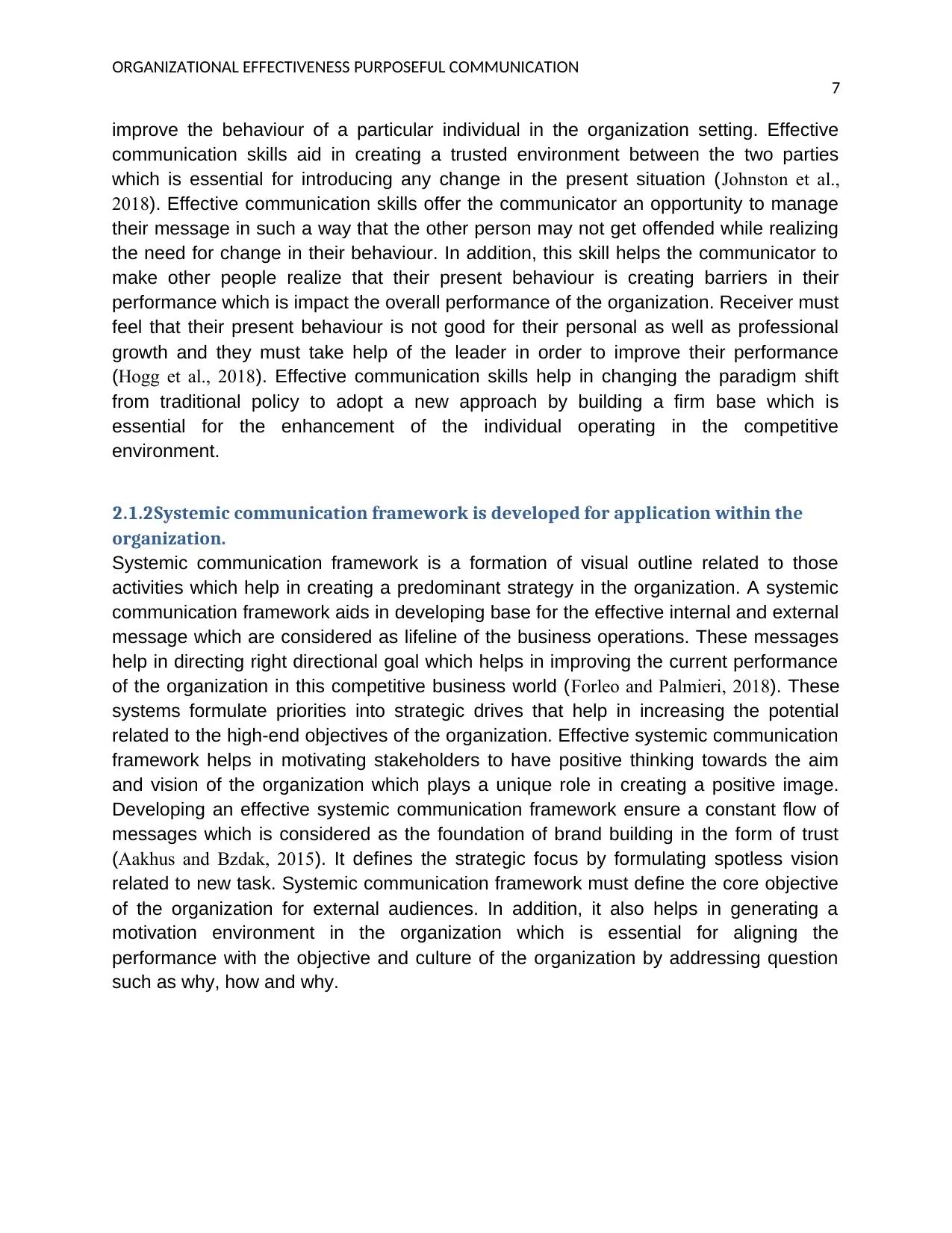
ORGANIZATIONAL EFFECTIVENESS PURPOSEFUL COMMUNICATION
7
improve the behaviour of a particular individual in the organization setting. Effective
communication skills aid in creating a trusted environment between the two parties
which is essential for introducing any change in the present situation (Johnston et al.,
2018). Effective communication skills offer the communicator an opportunity to manage
their message in such a way that the other person may not get offended while realizing
the need for change in their behaviour. In addition, this skill helps the communicator to
make other people realize that their present behaviour is creating barriers in their
performance which is impact the overall performance of the organization. Receiver must
feel that their present behaviour is not good for their personal as well as professional
growth and they must take help of the leader in order to improve their performance
(Hogg et al., 2018). Effective communication skills help in changing the paradigm shift
from traditional policy to adopt a new approach by building a firm base which is
essential for the enhancement of the individual operating in the competitive
environment.
2.1.2Systemic communication framework is developed for application within the
organization.
Systemic communication framework is a formation of visual outline related to those
activities which help in creating a predominant strategy in the organization. A systemic
communication framework aids in developing base for the effective internal and external
message which are considered as lifeline of the business operations. These messages
help in directing right directional goal which helps in improving the current performance
of the organization in this competitive business world (Forleo and Palmieri, 2018). These
systems formulate priorities into strategic drives that help in increasing the potential
related to the high-end objectives of the organization. Effective systemic communication
framework helps in motivating stakeholders to have positive thinking towards the aim
and vision of the organization which plays a unique role in creating a positive image.
Developing an effective systemic communication framework ensure a constant flow of
messages which is considered as the foundation of brand building in the form of trust
(Aakhus and Bzdak, 2015). It defines the strategic focus by formulating spotless vision
related to new task. Systemic communication framework must define the core objective
of the organization for external audiences. In addition, it also helps in generating a
motivation environment in the organization which is essential for aligning the
performance with the objective and culture of the organization by addressing question
such as why, how and why.
7
improve the behaviour of a particular individual in the organization setting. Effective
communication skills aid in creating a trusted environment between the two parties
which is essential for introducing any change in the present situation (Johnston et al.,
2018). Effective communication skills offer the communicator an opportunity to manage
their message in such a way that the other person may not get offended while realizing
the need for change in their behaviour. In addition, this skill helps the communicator to
make other people realize that their present behaviour is creating barriers in their
performance which is impact the overall performance of the organization. Receiver must
feel that their present behaviour is not good for their personal as well as professional
growth and they must take help of the leader in order to improve their performance
(Hogg et al., 2018). Effective communication skills help in changing the paradigm shift
from traditional policy to adopt a new approach by building a firm base which is
essential for the enhancement of the individual operating in the competitive
environment.
2.1.2Systemic communication framework is developed for application within the
organization.
Systemic communication framework is a formation of visual outline related to those
activities which help in creating a predominant strategy in the organization. A systemic
communication framework aids in developing base for the effective internal and external
message which are considered as lifeline of the business operations. These messages
help in directing right directional goal which helps in improving the current performance
of the organization in this competitive business world (Forleo and Palmieri, 2018). These
systems formulate priorities into strategic drives that help in increasing the potential
related to the high-end objectives of the organization. Effective systemic communication
framework helps in motivating stakeholders to have positive thinking towards the aim
and vision of the organization which plays a unique role in creating a positive image.
Developing an effective systemic communication framework ensure a constant flow of
messages which is considered as the foundation of brand building in the form of trust
(Aakhus and Bzdak, 2015). It defines the strategic focus by formulating spotless vision
related to new task. Systemic communication framework must define the core objective
of the organization for external audiences. In addition, it also helps in generating a
motivation environment in the organization which is essential for aligning the
performance with the objective and culture of the organization by addressing question
such as why, how and why.
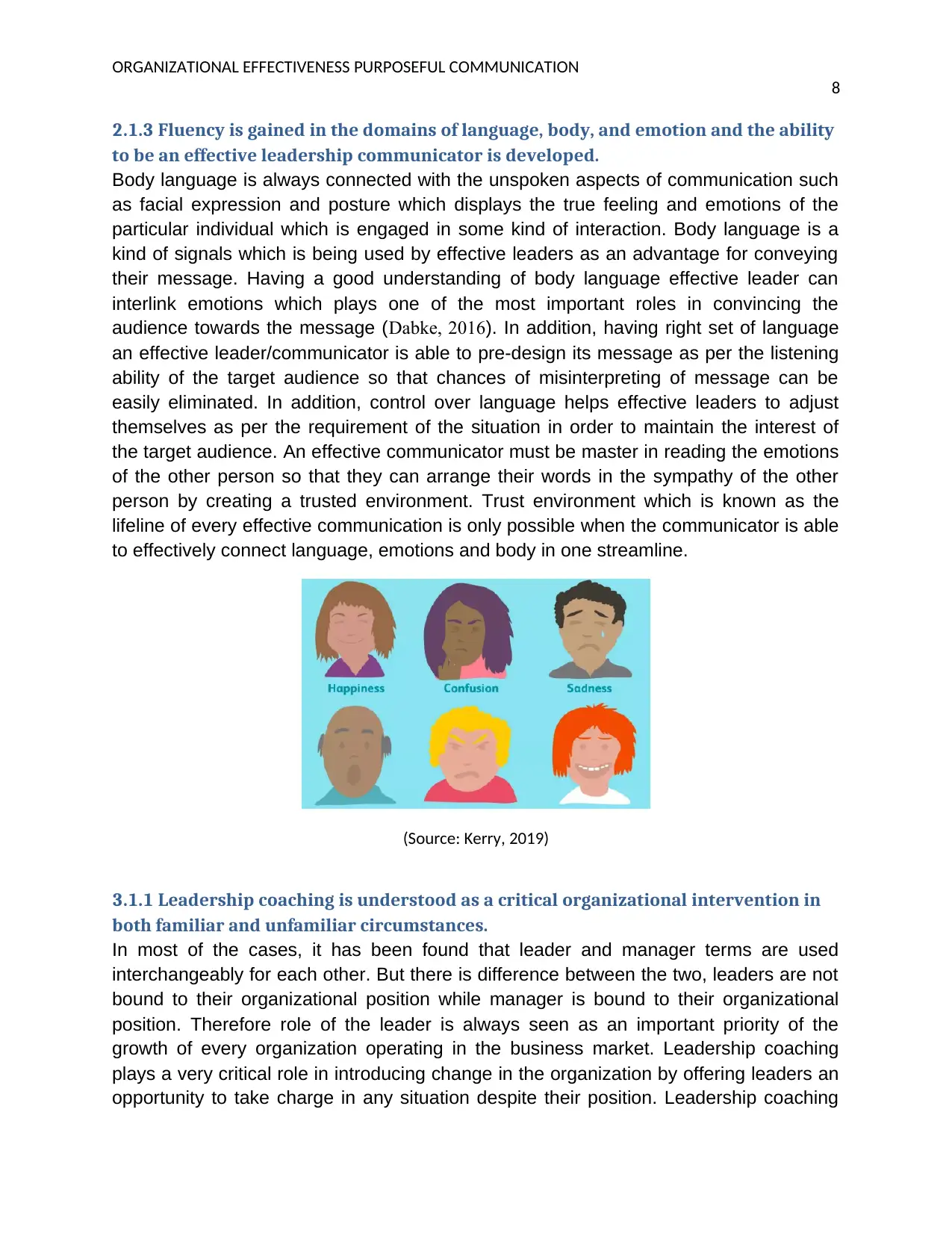
ORGANIZATIONAL EFFECTIVENESS PURPOSEFUL COMMUNICATION
8
2.1.3 Fluency is gained in the domains of language, body, and emotion and the ability
to be an effective leadership communicator is developed.
Body language is always connected with the unspoken aspects of communication such
as facial expression and posture which displays the true feeling and emotions of the
particular individual which is engaged in some kind of interaction. Body language is a
kind of signals which is being used by effective leaders as an advantage for conveying
their message. Having a good understanding of body language effective leader can
interlink emotions which plays one of the most important roles in convincing the
audience towards the message (Dabke, 2016). In addition, having right set of language
an effective leader/communicator is able to pre-design its message as per the listening
ability of the target audience so that chances of misinterpreting of message can be
easily eliminated. In addition, control over language helps effective leaders to adjust
themselves as per the requirement of the situation in order to maintain the interest of
the target audience. An effective communicator must be master in reading the emotions
of the other person so that they can arrange their words in the sympathy of the other
person by creating a trusted environment. Trust environment which is known as the
lifeline of every effective communication is only possible when the communicator is able
to effectively connect language, emotions and body in one streamline.
(Source: Kerry, 2019)
3.1.1 Leadership coaching is understood as a critical organizational intervention in
both familiar and unfamiliar circumstances.
In most of the cases, it has been found that leader and manager terms are used
interchangeably for each other. But there is difference between the two, leaders are not
bound to their organizational position while manager is bound to their organizational
position. Therefore role of the leader is always seen as an important priority of the
growth of every organization operating in the business market. Leadership coaching
plays a very critical role in introducing change in the organization by offering leaders an
opportunity to take charge in any situation despite their position. Leadership coaching
8
2.1.3 Fluency is gained in the domains of language, body, and emotion and the ability
to be an effective leadership communicator is developed.
Body language is always connected with the unspoken aspects of communication such
as facial expression and posture which displays the true feeling and emotions of the
particular individual which is engaged in some kind of interaction. Body language is a
kind of signals which is being used by effective leaders as an advantage for conveying
their message. Having a good understanding of body language effective leader can
interlink emotions which plays one of the most important roles in convincing the
audience towards the message (Dabke, 2016). In addition, having right set of language
an effective leader/communicator is able to pre-design its message as per the listening
ability of the target audience so that chances of misinterpreting of message can be
easily eliminated. In addition, control over language helps effective leaders to adjust
themselves as per the requirement of the situation in order to maintain the interest of
the target audience. An effective communicator must be master in reading the emotions
of the other person so that they can arrange their words in the sympathy of the other
person by creating a trusted environment. Trust environment which is known as the
lifeline of every effective communication is only possible when the communicator is able
to effectively connect language, emotions and body in one streamline.
(Source: Kerry, 2019)
3.1.1 Leadership coaching is understood as a critical organizational intervention in
both familiar and unfamiliar circumstances.
In most of the cases, it has been found that leader and manager terms are used
interchangeably for each other. But there is difference between the two, leaders are not
bound to their organizational position while manager is bound to their organizational
position. Therefore role of the leader is always seen as an important priority of the
growth of every organization operating in the business market. Leadership coaching
plays a very critical role in introducing change in the organization by offering leaders an
opportunity to take charge in any situation despite their position. Leadership coaching
⊘ This is a preview!⊘
Do you want full access?
Subscribe today to unlock all pages.

Trusted by 1+ million students worldwide
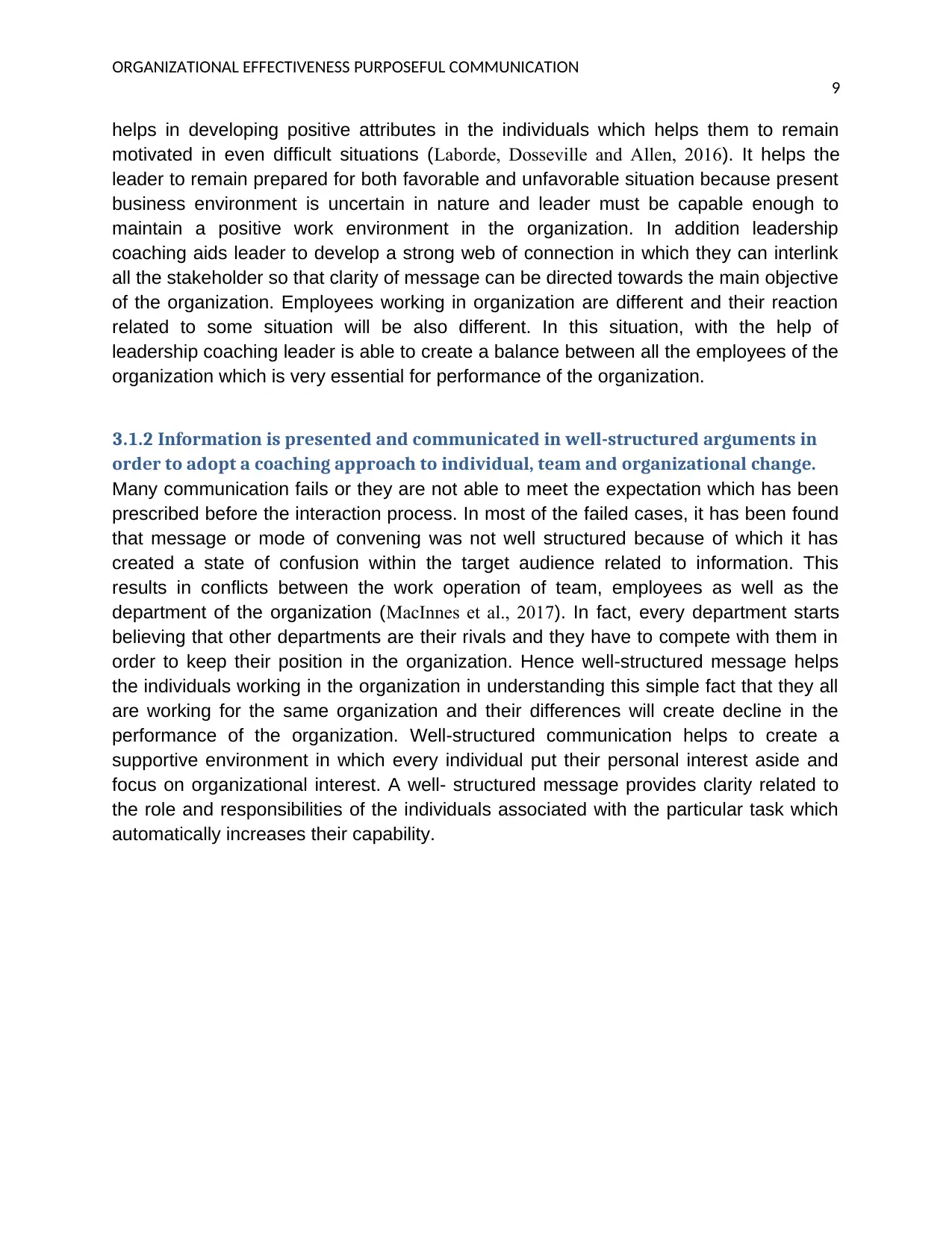
ORGANIZATIONAL EFFECTIVENESS PURPOSEFUL COMMUNICATION
9
helps in developing positive attributes in the individuals which helps them to remain
motivated in even difficult situations (Laborde, Dosseville and Allen, 2016). It helps the
leader to remain prepared for both favorable and unfavorable situation because present
business environment is uncertain in nature and leader must be capable enough to
maintain a positive work environment in the organization. In addition leadership
coaching aids leader to develop a strong web of connection in which they can interlink
all the stakeholder so that clarity of message can be directed towards the main objective
of the organization. Employees working in organization are different and their reaction
related to some situation will be also different. In this situation, with the help of
leadership coaching leader is able to create a balance between all the employees of the
organization which is very essential for performance of the organization.
3.1.2 Information is presented and communicated in well-structured arguments in
order to adopt a coaching approach to individual, team and organizational change.
Many communication fails or they are not able to meet the expectation which has been
prescribed before the interaction process. In most of the failed cases, it has been found
that message or mode of convening was not well structured because of which it has
created a state of confusion within the target audience related to information. This
results in conflicts between the work operation of team, employees as well as the
department of the organization (MacInnes et al., 2017). In fact, every department starts
believing that other departments are their rivals and they have to compete with them in
order to keep their position in the organization. Hence well-structured message helps
the individuals working in the organization in understanding this simple fact that they all
are working for the same organization and their differences will create decline in the
performance of the organization. Well-structured communication helps to create a
supportive environment in which every individual put their personal interest aside and
focus on organizational interest. A well- structured message provides clarity related to
the role and responsibilities of the individuals associated with the particular task which
automatically increases their capability.
9
helps in developing positive attributes in the individuals which helps them to remain
motivated in even difficult situations (Laborde, Dosseville and Allen, 2016). It helps the
leader to remain prepared for both favorable and unfavorable situation because present
business environment is uncertain in nature and leader must be capable enough to
maintain a positive work environment in the organization. In addition leadership
coaching aids leader to develop a strong web of connection in which they can interlink
all the stakeholder so that clarity of message can be directed towards the main objective
of the organization. Employees working in organization are different and their reaction
related to some situation will be also different. In this situation, with the help of
leadership coaching leader is able to create a balance between all the employees of the
organization which is very essential for performance of the organization.
3.1.2 Information is presented and communicated in well-structured arguments in
order to adopt a coaching approach to individual, team and organizational change.
Many communication fails or they are not able to meet the expectation which has been
prescribed before the interaction process. In most of the failed cases, it has been found
that message or mode of convening was not well structured because of which it has
created a state of confusion within the target audience related to information. This
results in conflicts between the work operation of team, employees as well as the
department of the organization (MacInnes et al., 2017). In fact, every department starts
believing that other departments are their rivals and they have to compete with them in
order to keep their position in the organization. Hence well-structured message helps
the individuals working in the organization in understanding this simple fact that they all
are working for the same organization and their differences will create decline in the
performance of the organization. Well-structured communication helps to create a
supportive environment in which every individual put their personal interest aside and
focus on organizational interest. A well- structured message provides clarity related to
the role and responsibilities of the individuals associated with the particular task which
automatically increases their capability.
Paraphrase This Document
Need a fresh take? Get an instant paraphrase of this document with our AI Paraphraser
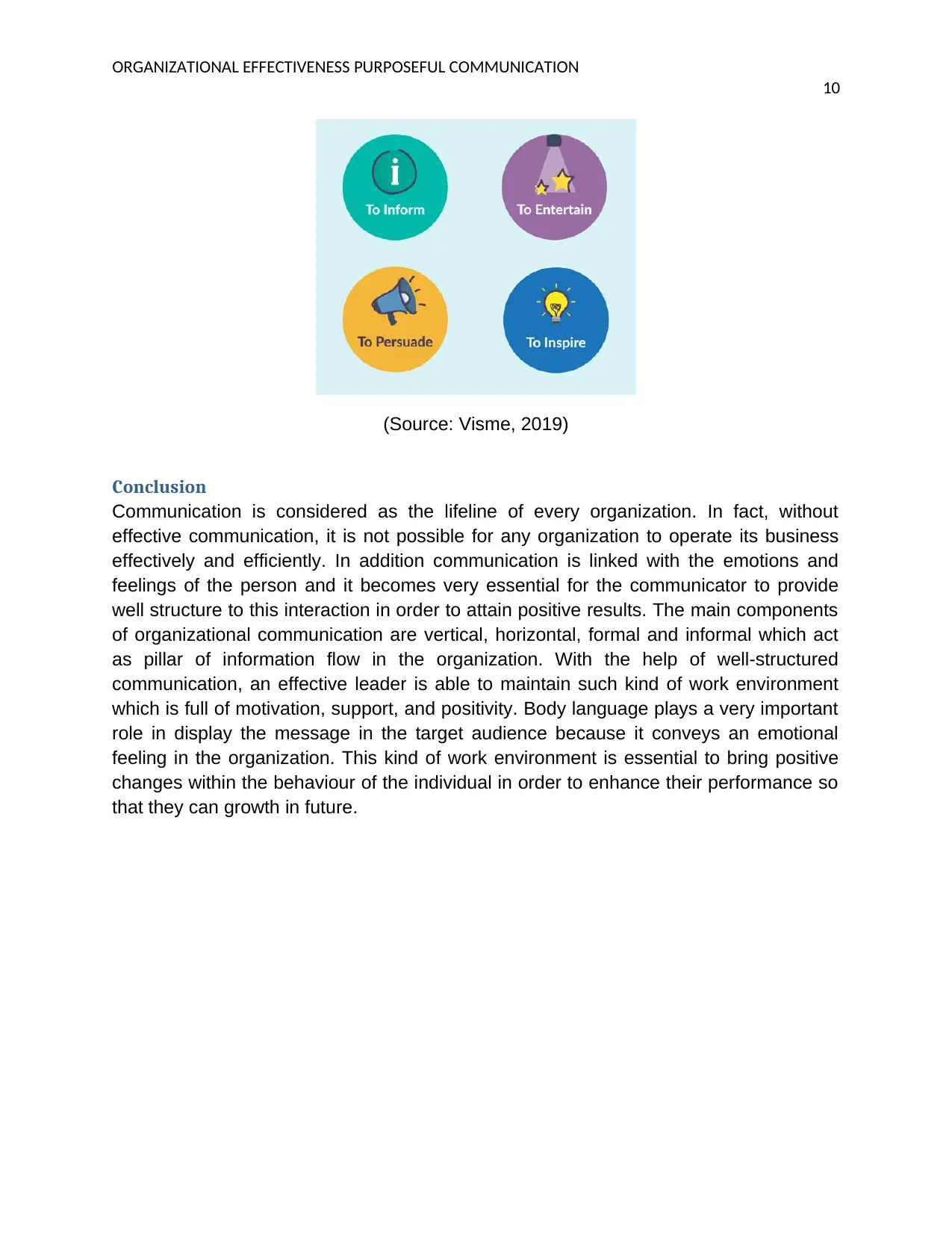
ORGANIZATIONAL EFFECTIVENESS PURPOSEFUL COMMUNICATION
10
(Source: Visme, 2019)
Conclusion
Communication is considered as the lifeline of every organization. In fact, without
effective communication, it is not possible for any organization to operate its business
effectively and efficiently. In addition communication is linked with the emotions and
feelings of the person and it becomes very essential for the communicator to provide
well structure to this interaction in order to attain positive results. The main components
of organizational communication are vertical, horizontal, formal and informal which act
as pillar of information flow in the organization. With the help of well-structured
communication, an effective leader is able to maintain such kind of work environment
which is full of motivation, support, and positivity. Body language plays a very important
role in display the message in the target audience because it conveys an emotional
feeling in the organization. This kind of work environment is essential to bring positive
changes within the behaviour of the individual in order to enhance their performance so
that they can growth in future.
10
(Source: Visme, 2019)
Conclusion
Communication is considered as the lifeline of every organization. In fact, without
effective communication, it is not possible for any organization to operate its business
effectively and efficiently. In addition communication is linked with the emotions and
feelings of the person and it becomes very essential for the communicator to provide
well structure to this interaction in order to attain positive results. The main components
of organizational communication are vertical, horizontal, formal and informal which act
as pillar of information flow in the organization. With the help of well-structured
communication, an effective leader is able to maintain such kind of work environment
which is full of motivation, support, and positivity. Body language plays a very important
role in display the message in the target audience because it conveys an emotional
feeling in the organization. This kind of work environment is essential to bring positive
changes within the behaviour of the individual in order to enhance their performance so
that they can growth in future.
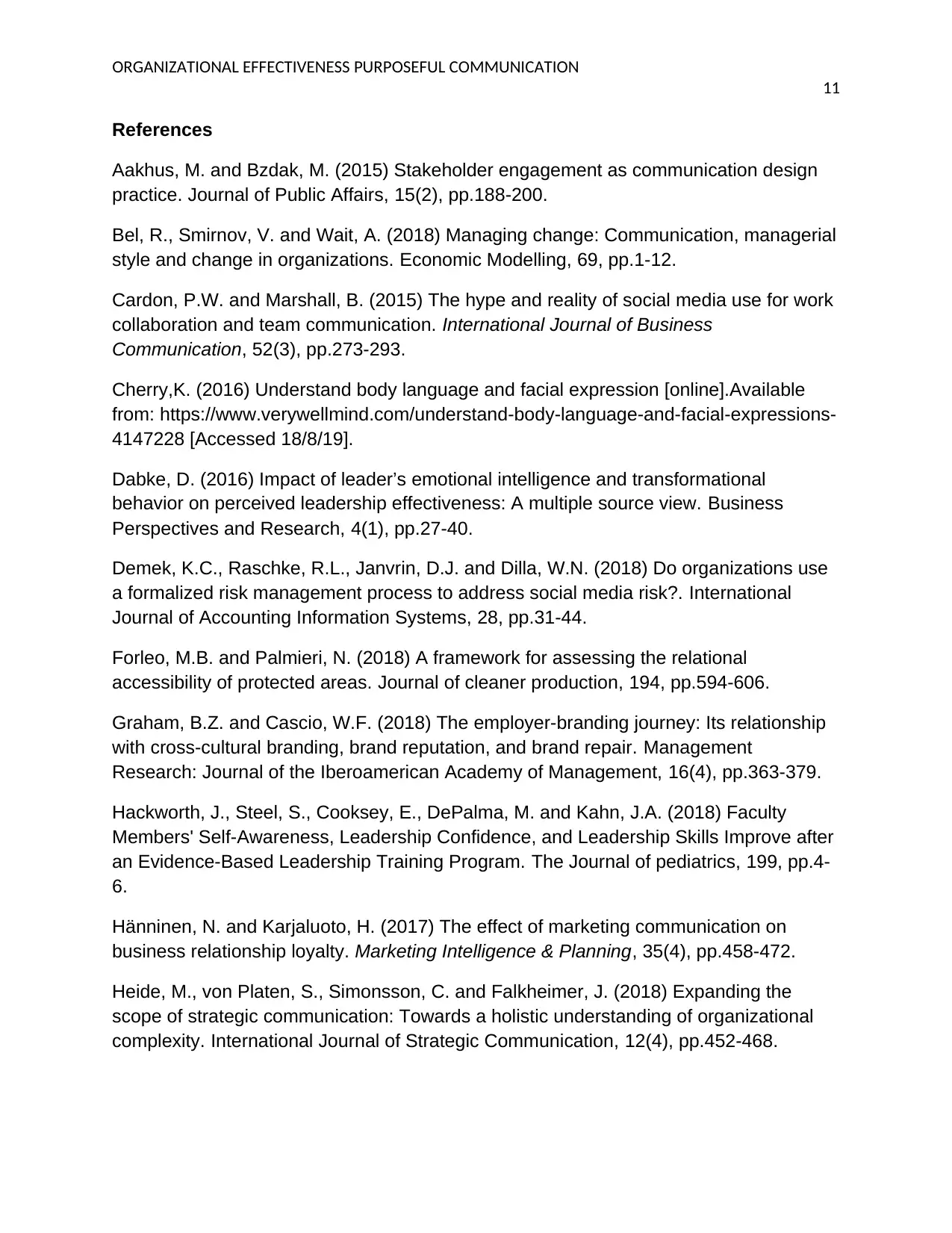
ORGANIZATIONAL EFFECTIVENESS PURPOSEFUL COMMUNICATION
11
References
Aakhus, M. and Bzdak, M. (2015) Stakeholder engagement as communication design
practice. Journal of Public Affairs, 15(2), pp.188-200.
Bel, R., Smirnov, V. and Wait, A. (2018) Managing change: Communication, managerial
style and change in organizations. Economic Modelling, 69, pp.1-12.
Cardon, P.W. and Marshall, B. (2015) The hype and reality of social media use for work
collaboration and team communication. International Journal of Business
Communication, 52(3), pp.273-293.
Cherry,K. (2016) Understand body language and facial expression [online].Available
from: https://www.verywellmind.com/understand-body-language-and-facial-expressions-
4147228 [Accessed 18/8/19].
Dabke, D. (2016) Impact of leader’s emotional intelligence and transformational
behavior on perceived leadership effectiveness: A multiple source view. Business
Perspectives and Research, 4(1), pp.27-40.
Demek, K.C., Raschke, R.L., Janvrin, D.J. and Dilla, W.N. (2018) Do organizations use
a formalized risk management process to address social media risk?. International
Journal of Accounting Information Systems, 28, pp.31-44.
Forleo, M.B. and Palmieri, N. (2018) A framework for assessing the relational
accessibility of protected areas. Journal of cleaner production, 194, pp.594-606.
Graham, B.Z. and Cascio, W.F. (2018) The employer-branding journey: Its relationship
with cross-cultural branding, brand reputation, and brand repair. Management
Research: Journal of the Iberoamerican Academy of Management, 16(4), pp.363-379.
Hackworth, J., Steel, S., Cooksey, E., DePalma, M. and Kahn, J.A. (2018) Faculty
Members' Self-Awareness, Leadership Confidence, and Leadership Skills Improve after
an Evidence-Based Leadership Training Program. The Journal of pediatrics, 199, pp.4-
6.
Hänninen, N. and Karjaluoto, H. (2017) The effect of marketing communication on
business relationship loyalty. Marketing Intelligence & Planning, 35(4), pp.458-472.
Heide, M., von Platen, S., Simonsson, C. and Falkheimer, J. (2018) Expanding the
scope of strategic communication: Towards a holistic understanding of organizational
complexity. International Journal of Strategic Communication, 12(4), pp.452-468.
11
References
Aakhus, M. and Bzdak, M. (2015) Stakeholder engagement as communication design
practice. Journal of Public Affairs, 15(2), pp.188-200.
Bel, R., Smirnov, V. and Wait, A. (2018) Managing change: Communication, managerial
style and change in organizations. Economic Modelling, 69, pp.1-12.
Cardon, P.W. and Marshall, B. (2015) The hype and reality of social media use for work
collaboration and team communication. International Journal of Business
Communication, 52(3), pp.273-293.
Cherry,K. (2016) Understand body language and facial expression [online].Available
from: https://www.verywellmind.com/understand-body-language-and-facial-expressions-
4147228 [Accessed 18/8/19].
Dabke, D. (2016) Impact of leader’s emotional intelligence and transformational
behavior on perceived leadership effectiveness: A multiple source view. Business
Perspectives and Research, 4(1), pp.27-40.
Demek, K.C., Raschke, R.L., Janvrin, D.J. and Dilla, W.N. (2018) Do organizations use
a formalized risk management process to address social media risk?. International
Journal of Accounting Information Systems, 28, pp.31-44.
Forleo, M.B. and Palmieri, N. (2018) A framework for assessing the relational
accessibility of protected areas. Journal of cleaner production, 194, pp.594-606.
Graham, B.Z. and Cascio, W.F. (2018) The employer-branding journey: Its relationship
with cross-cultural branding, brand reputation, and brand repair. Management
Research: Journal of the Iberoamerican Academy of Management, 16(4), pp.363-379.
Hackworth, J., Steel, S., Cooksey, E., DePalma, M. and Kahn, J.A. (2018) Faculty
Members' Self-Awareness, Leadership Confidence, and Leadership Skills Improve after
an Evidence-Based Leadership Training Program. The Journal of pediatrics, 199, pp.4-
6.
Hänninen, N. and Karjaluoto, H. (2017) The effect of marketing communication on
business relationship loyalty. Marketing Intelligence & Planning, 35(4), pp.458-472.
Heide, M., von Platen, S., Simonsson, C. and Falkheimer, J. (2018) Expanding the
scope of strategic communication: Towards a holistic understanding of organizational
complexity. International Journal of Strategic Communication, 12(4), pp.452-468.
⊘ This is a preview!⊘
Do you want full access?
Subscribe today to unlock all pages.

Trusted by 1+ million students worldwide
1 out of 14
Related Documents
Your All-in-One AI-Powered Toolkit for Academic Success.
+13062052269
info@desklib.com
Available 24*7 on WhatsApp / Email
![[object Object]](/_next/static/media/star-bottom.7253800d.svg)
Unlock your academic potential
Copyright © 2020–2025 A2Z Services. All Rights Reserved. Developed and managed by ZUCOL.





